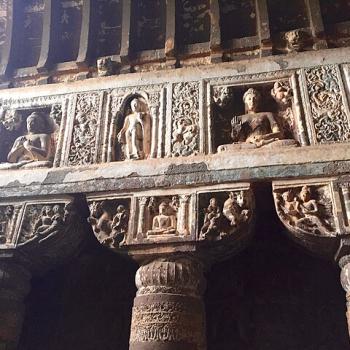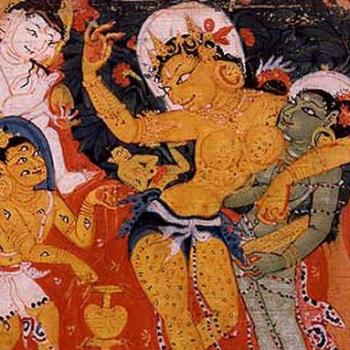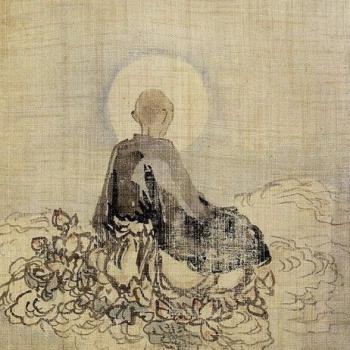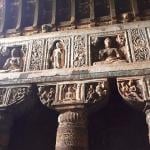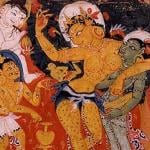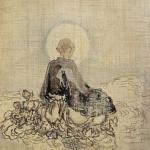DON’T BELIEVE ANYTHING YOU THINK
A Reflection on Awakening in Zen
James Myoun Ford
in conversation with
Josh Bartok
Melissa Blacker
& David Rynick
The Case
Case 51
The Fifty-first Ancestor, Eihei Dogen Osho
Eihei Dogen Osho came to Tiantong Osho. One day, Tiantong preached to his assembly at early morning meditation, saying, “Zazen is a falling away of body and mind.” Dogen, hearing this, suddenly had great realization. He went at once to the abbot’s chambers and offered incense.
Tiantong asked him, “Why do you offer incense?”
Dogen said, “I have come with body and mind fallen away.”
Tiantong said, “Body and mind fallen away. The fallen away body and mind.”
Dogen said, “That is a momentary achievement. Your Reverence must not confirm me too hastily.”
Tiantong said, “I do not confirm you hastily.”
Dogen said, “What is this not-hastily-confirming?”
Tiantong said, “The fallen away body and mind.”
The Master made his bows.
Tiantong said, “Fallen away, fallen away.”
At that time, his attendant Huangping of Fuzhou said, “It is truly not a trifling thing for a foreigner to attain to such a degree.”
Tiantong said, “Before he came here, he received the blows of many fists.
Sometimes he was fallen away and composed.
Sometimes he was like a clap of thunder.”
Poem:
The ground, clear and bright, has neither surface nor inside;
How can there be body and mind which would drop away?
Keizan’s The Transmission of Light
Translated by Joan Sutherland & John Tarrant
I think the first time I saw the bumper sticker I’d accepted the call of the Unitarian Universalist congregation in Newton, Massachusetts, and Jan, auntie, our two cats and I were driving from the Phoenix suburbs to Boston’s suburbs. We were in Texas. It was a long stretch of road with not particularly heavy traffic. Then, even though we were moving at a pretty good pace a genuinely antique Volkswagen bus overtook and rather quickly passed us. I found that a rather improbable thing, we were going pretty fast.
But what really caught me was the single bumper sticker on the back of the bus. I read it a couple of times before the bus pulled far enough in front for me to no longer be able to read the words. Didn’t matter, they were imprinted.
The slogan was simple enough.
“Don’t believe everything you think.”
I found it delightful. A good bit of advice for anyone, but particularly for anyone on the Zen way. I would begin to repeat it in talks. And eventually when our little Zen group in Newton decided that it was time for us to have a t-shirt, that was the slogan emblazoned on the front.
“Don’t believe everything you think.”
Fast-forward a decade and a bit. Recently I received a note also copied to Melissa Blacker and David Rynick, co-teachers of the Boundless Way project. It was from Josh Bartok, my senior student and teacher at our Boundless Way sangha in Boston. He was ruminating on that famous passage cited in several places but enshrined in our koan curriculum in as the fifty-first case in Keizan’s masterwork The Transmission of Light. Typical of what are called “lamp” anthologies, this is a collection of stories of the masters, in this case focusing on the lineage, mythic and historic that led to Keizan Jokin, founder of Sojiji Zen temple and generally considered as second only to Dogen as a founder of Japanese Soto Zen.
Josh has been ruminating on the nature of the awakening experience, as captured in many Zen circles within that line about dropping away of body and mind. He noted “in my reading and research, I’ve discerned two views: (1) ‘dropping off body and mind’ is a special state of mind, a special state of samadhi (2) ‘dropping off body and mind’ is nothing special, is the practice of zazen itself, moment to moment, samadhi or no samadhi.”
This reflects, of course, the great tension within the Zen schools. It dates back at least to the emergence of a coherent Zen school and the debates between the Northern and Southern branches of our school. The so-called Northern branch advocates spoke of diligent cultivation and “gradual enlightenment,” and unfolding of wisdom, like the pedals of a lotus opening on the surface of a pond. While advocates of the so-called Southern branch advocated “sudden enlightenment” as a blinding flash of insight that transformed the person forever more.
To read the Platform Sutra one would think the whole thing was settled in favor of “sudden enlightenment.” Actually the argument just shifted a bit. By the Thirteenth century two nascent schools emerged, each carrying the flag for a different approach to the same great end, our salvific vision of what actually is. The Caodong was closely associated with the path of silent illumination and which would reach its theological flowering in the teachings of the Japanese master Eihei Dogen. The Linji would turn on koan introspection, which arguably found its flower in the koan curricula system associated with the Eighteenth century Japanese master Hakuin Ekaku. The former focused on the practice as enlightenment, the later gave more attention to those deeply personal encounters.
I find it very interesting to note that it is Dogen, the great advocate for just sitting as awakening itself, in quoting his own teacher, is the source of the line “dropping off body and mind,” which is generally seen as a description of the enlightenment experience. Kensho, seeing into one’s own nature is expressed in our Zen way as a twin insight into the exact identity of the world we experience and our very selves, and at the same time, in the same space, each and everything including ourselves, is without substance, is empty, is boundless. Here awakening is seeing form and emptiness as two sides of a single coin. And here Dogen describes his own experience of it.
Now in my experience nearly everyone has had a kensho experience, some insight shallow or deep into that place which includes our selves and something larger at the same moment. Often it is described as a moment of oneness, but I’ve heard other words, and occasionally admission that no word quite works. And it is my experience that those who follow the koan way have more of these moments than others. But, most importantly, I haven’t actually seen those who’ve had these experiences, transform their lives quite as totally and beautifully as is described in the literature. As one who has had these experiences I can say, sadly, how quickly they can become fond memories.
I’ve also noticed that while people who just sit tend to have fewer of these moments than their koanic sisters and brothers, they nonetheless don’t seem to be less insightful, or less kind, or in any discernable way less manifesting the way. So, something not quite consonant with the literature is going on.
Now some who’ve thought about it discriminate between kinds of kensho and assert that only kenshos experienced within deep samadhi are real kenshos, or kensho worthy of the name. I’ve met a lot of people on the path, who romance deep samadhi. And I have to say of the quality of their product, not so different as I could tell. In fact it often seems the real shift is from a too heavy an emphasis on kensho, to a too heavy emphasis on samahdi, the deep state of quiet associated with Zazen, shikantaza.
So, what is kensho, really? Josh goes on to ruminate “I’ve recently read the chapter of the Shurangama Sutra “Warnings to Practitioners: The Fifty False States Caused by the Five Aggregates’—which is generally interpreted as a categorization of certain kinds of advanced makyo. In all of the cases it gives some kind of special experience, and says, ‘This state is not sainthood but if you recognize that fact and otherwise ignore it, it is a mark that all is proceeding well. If you don’t see through it or interpret it as arhantship, sainthood, enlightenment etc, then you succumb to demons.’”
Makyo is another term of art in Zen. It is used to name all special experiences; visual, auditory, sensory that often accompany practice, particularly intensive practice. In general the rule of response from a Zen teacher when presented with a report of such experiences is “Don’t worry, they’ll pass.” So, the question here is, is kensho just a “higher” kind of makyo, perhaps more useful, but nonetheless nothing to cling to? And therefore don’t worry, it will pass.
The nice thing for me is give Josh a little time, and he’ll usually answer the question. “Dogen,” Josh observes, “unlike Rujing, adds ‘dropping off the body and mind -of others-‘ which I think argues against the case that ‘Dropping off body and mind’ has anything special to do with any content of my own phenomenological experience, my own little tiny experience of consciousness. And I feel that another passage in Genjokoan—where he says that from the middle of a boat in the ocean, the horizon of the ocean always appears to us visually as a circle—never as not a circle in any circumstances; nonetheless the horizon and the ocean are not a circle. This phrase is also comforting with regard to the ‘all sentient beings have disorderly karmic consciousness’—i.e., there’s not any -other- kind of consciousness we as sentient beings should replace our karmic consciousness with….”
I think this is close to the mark. Kensho is about plugging into what is. We don’t have these experiences. Rather we are normally blocking the larger reality, for all sorts of reasons, but nonetheless blocking. And then within our lives, at moments, with fireworks or not, we move into harmony with that larger truth. We plug in. We are harmonious. Then, and there’s always a then; then something different.
Our experience is not what it is; our experience is itself so partial to call it the real is at best only a pointer, and at worst terribly misleading. In an ideal world nothing would be said. But, as Dainin Katagiri dryly observed, somewhere along the line “you have to say something.” This is the world we live in, and we have to say something. The whole thing is eternally now, and we live in time and have to act and respond and act again. And we have to say something.
My dear friend and teaching colleague David Rynick responded to all this succinctly. Saying I “would choose both (1) and (2) on my response to the question. There is some kind of experience that is not sort of like dropping off body and mind, but is just like that. And it appears that with this experience and $3.85 you can get a grande latte – and your life is changed. And your life is changed moment to moment. There is a gradual and fully mysterious wisdom that comes as we do the gradual work.”
This is not being nice, saying both kensho and silent illumination are the same. Rather whether nice or not, kensho and silent illumination and cultivation all share the same root, and to preference one is to miss something.
My Dharma heir, friend and teaching colleague, Melissa Blacker expanded on this a bit. “I myself had an experience that, when I first read Dogen, seemed to map onto his ‘dropping off body and mind.’ But it was an experience that was dynamic, and not at all static or finished. It eventually changed (in spite of my deluded desire to hold onto it and make it permanent) into his later response – ‘I learned that my nose is vertical and my eyes are horizontal.’ I felt that I had experienced something I could call emptiness, and then my personal work became the integration of that experience into the world of form.
“What I see in working with folks is that sometimes there’s a kind of lights and fireworks experience on one end of the spectrum, and sometimes there’s a little ‘oh!’ moment that’s quite subtle on the other end. And everything in between. When someone feels they haven’t had an experience that sounds like the words or description (always limited, even in the case of a genius like Dogen) of someone they’ve heard about or read about, I encourage them to notice the rising of a comparing mind, one that’s creating a construction based on something that can’t be known second-hand. And I look for some degree of understanding of emptiness and form, and how that’s manifesting in their actual lived lives.”
So, back to that bumper sticker. Over time I realized it wasn’t quite right. Oh, pretty good, great for a bumper sticker, and not a bad practice point. Question authority to the max; question even your own thoughts, even my own thoughts.
But in fact the deal is rather more rigorous.
Yes, we have experiences. All the time. Sometimes we name them. Sometimes we paint ‘em gold and build shrines around them. This is sometimes such a problem that teachers like Joko Beck will relegate reports of kensho as trifling things, small intimations.
The real deal is found as we put down our ideas of what should and should not be.
The deal is more radical than don’t believe everything you think.
Rather.
Don’t believe anything you think.
Anything.
Just put it down.
Just let your grasping hand open up.
And all will be revealed.
That revealed will include each moment. That revealed will include an eternal now, a boundless reality of which we are all a part.
And then we get to start all over again.
Perhaps renewed.
Perhaps not.
But the very action is the saving grace of the world.
And that is the Zen way.



